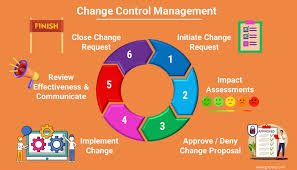Change Control in Pharmaceuticals | Process, Documentation, and GMP Compliance Guide

Change Control in Pharmaceuticals
Definition:
Change control is a formal GMP-compliant system used to manage and document any change in processes, equipment, materials, methods, documents, or facilities to ensure that product quality, safety, and regulatory compliance are maintained.
Purpose
-
Ensure all changes are evaluated, approved, and documented before implementation.
-
Minimize risks to product quality, patient safety, and compliance.
-
Maintain data integrity and traceability.
Types of Changes
-
Major Changes – High potential impact on quality/compliance (e.g., change in manufacturing site, formulation change).
-
Minor Changes – Low or no direct impact on quality (e.g., correction of document typo).
-
Regulatory Changes – Require prior approval from regulatory authorities before implementation.
Change Control Process
1. Initiation
-
Change proposal submitted by the concerned department.
-
Assign a unique Change Control (CC) number.
-
Document:
-
Description of change
-
Reason for change
-
Reference documents (SOPs, batch records)
-
2. Impact Assessment
-
Evaluate impact on:
-
Product quality
-
Process validation
-
Regulatory filings
-
Equipment qualification
-
Training needs
-
-
Use risk assessment tools (FMEA, Risk Matrix).
3. Review & Approval
-
QA/QC, Production, Engineering, and Regulatory Affairs review the proposal.
-
QA ensures all risks are mitigated before approval.
4. Implementation
-
Carry out the change according to approved plan.
-
Provide training if required.
-
Update related documents/SOPs.
5. Verification
-
Confirm that the change meets expected outcomes.
-
Conduct validation or requalification if necessary.
6. Closure
-
QA reviews implementation records.
-
Close CC record in QMS.
-
Archive documentation for GMP record retention period.
Documentation Requirements (as per GMP)
-
Unique CC number
-
Description & rationale of change
-
Impact assessment results
-
Approval signatures & dates
-
Implementation plan & records
-
Verification & validation reports
-
Closure details
GMP Compliance Points
-
All changes must be approved before implementation (except urgent corrective actions with immediate QA notification).
-
Follow ALCOA+ principles for data integrity.
-
Maintain a Change Control Log for traceability.
-
Conduct periodic trend analysis to identify recurring changes and improve processes.
-
Ensure regulatory submissions are made when required.
✅ Simplified Flow:
Proposal → Impact Assessment → QA Review → Approval → Implementation → Verification → Closure → Trending
🎓 Discover one of the best Pharmaceutical Quality Assurance course available —click below to explore the course that’s shaping future Quality Assurance skills.
https://trcjw.on-app.in/app/oc/306166/trcjw

